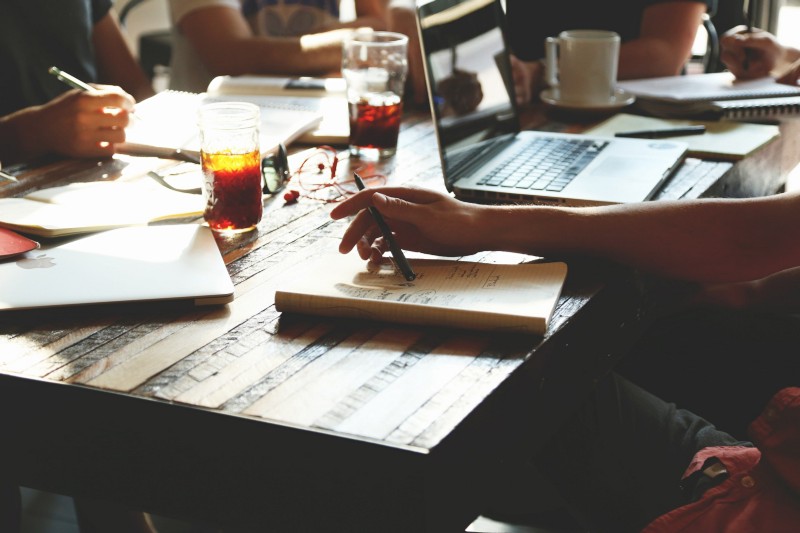By Lucy Dotson
I got sick of holding nebulous, time-consuming meetings. So I asked three design managers how they approach the meeting problem.

Design practitioners love to loathe meetings, and I’m as guilty as the last. Meetings mean more time spent talking, and less time spent designing. They often involve explaining old ideas rather than generating new ones. At their worst, meetings waste time and drain project momentum.
A great meeting, on the other hand, is like an espresso shot: brief and energizing. It provides everyone with a clear understanding of the project goals, each person’s role and responsibilities, and the immediate next action.
If your meetings elicit eye-rolls, vacant stares and covert texting, you’re in luck. You can take a few steps to dramatically improve the experience for designers and non-designers alike.
I reached out to four design managers at successful mid-sized startups to learn how they approach design meetings. Here are a few steps to get you going:
First, determine if the meeting is necessary.
Sometimes a meeting lacks momentum because it doesn’t actually need to happen. Figuring out what people hope to get from a proposed meeting is an important first step.
Jono Lee, Lead Product Designer at Disqus
“Before putting a meeting on the calendar, I ask around to make sure it’s actually necessary. I’ll ask myself why I want to hold the meeting in the first place, and identify a specific goal. Then, I consider whether the goal is achievable through a quick chat, a meeting, or another channel. I only set up a meeting if I know that we will get something out of it in the end.”
Andy Montgomery, Head of Design at Recurly
“One of my core philosophies around design and leading other designers is doing everything I can to let my team focus. Fewer meetings yields more focus, and more focus yields good design work. I try to keep meetings at a minimum, so my designers can make good design decisions, immerse themselves in the work, and iterate to create good work.”
Then, define high-level goals and an agenda.
High-level goals can guide your team through the murky parts of a complicated meeting. In addition to defining what work to talk about, define values and what you want to achieve.
Jono Lee, Disqus
“I start [preparing for a meeting] by clearly delineating a specific goal. I send out material beforehand, and make sure that everyone reads it. People tend to focus on what’s in front of them (a button color, a line length), so before I show stakeholders anything, we talk through the high level goals.”
Andy Montgomery, Recurly
“An agenda that delineates what’s happening and what you want to accomplish is essential to a successful meeting. It looks something like: the purpose of the meeting, a productive period in the middle, and then discussing next steps. I hold meetings early on in the process, so that everyone can get clear on the project goals, the problem we’re trying to solve, and a few potential solutions. In these early meetings, the team gets the tools and answers they need to move forward.”
Strike a balance between talking and doing.
A common complaint about meetings is that they eat into productive work time. Incorporating workshop elements into your meetings boosts engagement and excitement.
Bryan Keller, Director of User Experience at Adaptly
“My favorite types of meetings are workshops. In a typical meeting, the conversation takes place in one dimension — only one person can talk at a time, and there’s not much that people can put their hands on. UX problems are difficult to work through in one dimension. Whereas meetings are generally boring and unproductive, good workshops are fun and very productive.”
Jono Lee, Disqus
“A good meeting walks the line between talking and doing. The project lead is responsible for facilitating decisions and shepherding the project through all stages. At some point in a meeting, you’ll have to come to a decision, and sometimes it’s hard for people to do that. The project lead can drive that decision-making by bringing people’s attention back to the goals at hand.”
Andy Montgomery, Recurly
“When in a design meeting, start whiteboarding as quickly as possible. It provides both documentation and structure for the conversation, and it keeps the meeting from spiraling elsewhere. When in doubt, you can return to the board and point to things.”
Break bad habits.
If you’ve been holding bad meetings for a while, your team may have developed corresponding bad habits. If so, you may need to reset behaviors either inside or outside of the scheduled meeting time.
Bryan Keller, Adaptly
“If the team has developed bad habits around meetings, it’s helpful to put a working agreement in place. Establish some ground rules you can all agree on. For instance, if not enough people show up to a meeting within 5 minutes of the scheduled start time, then the meeting gets rescheduled. There should only be one conversation happening at a time. No phones or laptops allowed, and so on. Make sure everyone knows and can see these rules.”
Andy Montgomery, Recurly
“Occasionally in a meeting, people get into a cycle of opinion expressing. When that happens, I go back to the goals, and lean on them pretty heavily. I also require designers to be articulate about the decisions they make. This encourages them to reach out to stakeholders to get answers, and ultimately leads to greater precision.”
Want to be featured on Designers Say? Email me at lucy@tradecrafted.com.
This entry passed through the Full-Text RSS service - if this is your content and you're reading it on someone else's site, please read the FAQ at fivefilters.org/content-only/faq.php#publishers.
